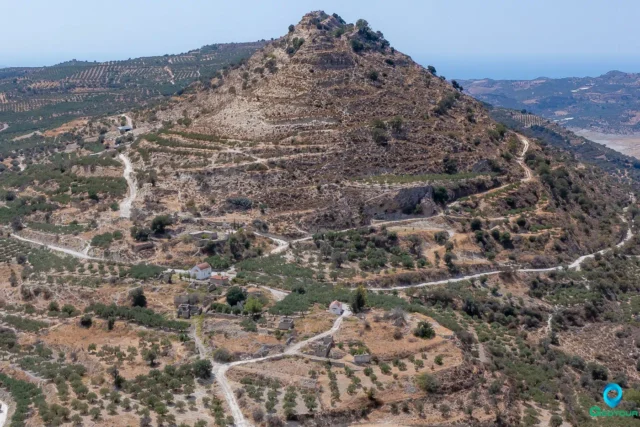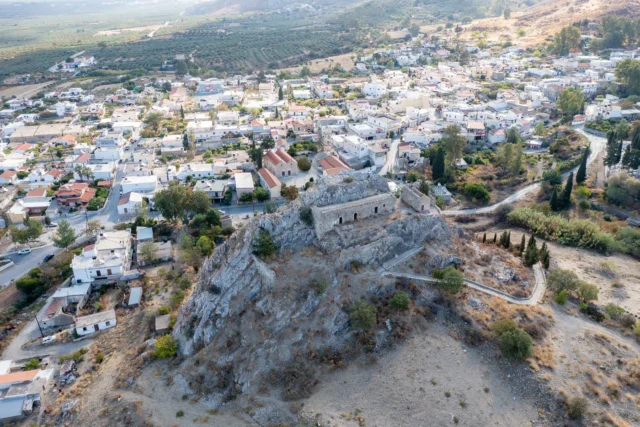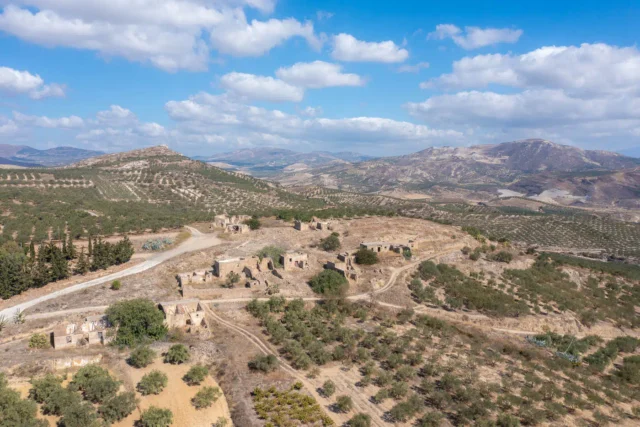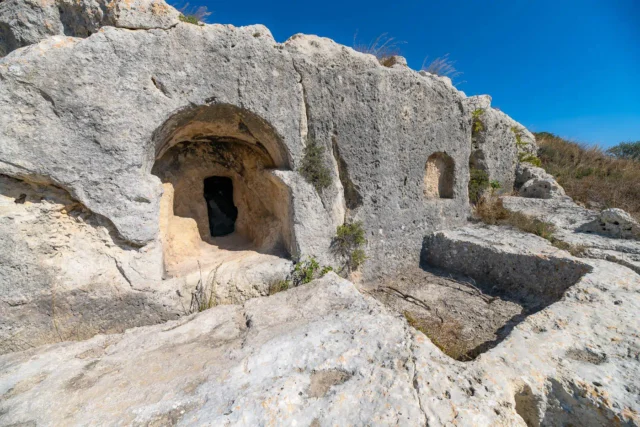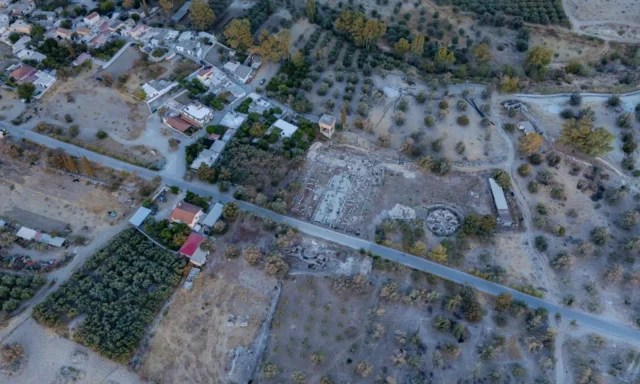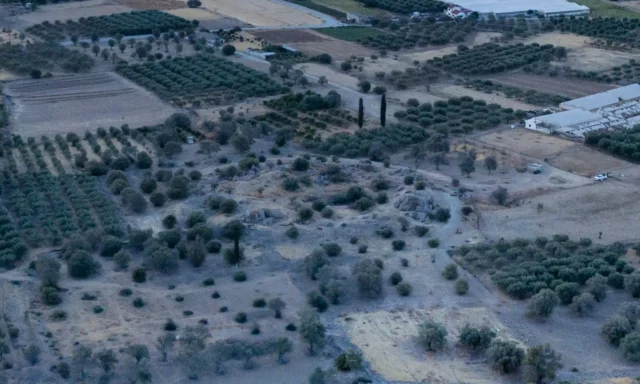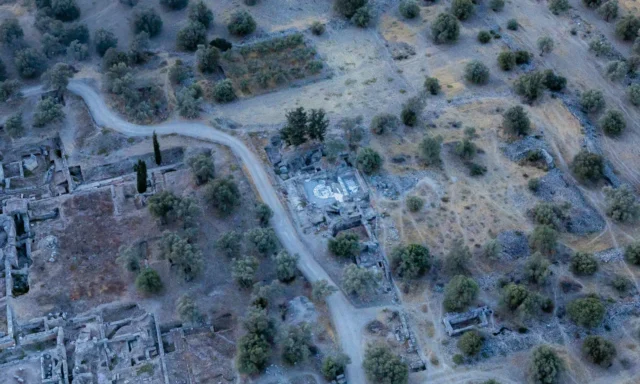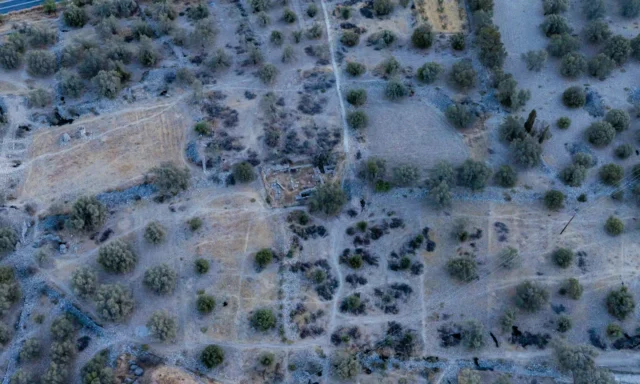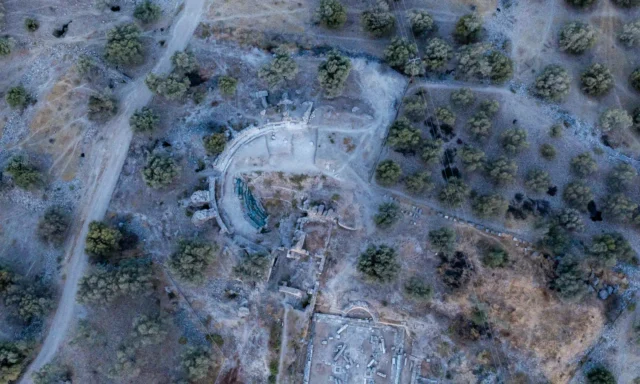80
listings found
Categories
Active filters:
The Circus at Gortyn
A significant Roman spectacle complex at the southeastern edge of Gortyn, the provincial capital of Crete and Cyrenaica. Constructed in the Severan period (early 3rd century CE) along with the amphitheater, it was a key entertainment venue. Primarily used for circus games and racing, its importance is noted in mid-4th century texts like the Expositio totius mundi et gentium. The venue likely had looser seating arrangements than amphitheaters. Its creation was part of an intensive construction phase.
Gerokampos Tholos Tomb
The Lebena Gerokampos Tholos Tomb is an Early Minoan I-II (c. 3100-2600 BCE) archaeological site located near Lentas, on the southern coast of Crete, close to the ancient Minoan settlement of Lebena. The tomb, with an interior diameter of approximately 5 meters, is typical of tholos tombs, with a circular chamber built of large stones and a corbelled vault. The tomb also features several smaller chambers or annexes, which were added later. These annexes, along with the main tholos, served as spaces for burial and ritual activities. A large quantity of pottery, including pyxides, tankards, cups, and bowls, was found in the tomb. The tomb contained the skeletal remains of numerous individuals, providing evidence of collective burial practices. Other significant finds from the tomb include jewelry, tools, and figurines.
Kourtes, Gortyna
Kourtes, a deserted village in southern Heraklion, Crete, reveals Byzantine and Ottoman history. The name suggests a possible Byzantine military base. Located 3km south of Zaros, it comprises Pano and Kato Kourtes ruins, with the Three Hierarchs church remaining from Mesochori. The site includes Late Minoan tombs, an ancient Roman-era aqueduct with caves and a cistern, and remnants of a pottery kiln, reflecting its past agricultural and craft traditions. Historical records show Ottoman and Christian populations, with a gradual decline to its current deserted state. Churches include Agios Georgios, Three Hierarchs, and Christ.
Psalida abandoned village
Psalida (Ψαλίδα), an abandoned village in Gergeri, Crete, offers a glimpse into the island's past. Dating back to the 16th century, the village was once home to farmers, as evidenced by animal feeders found in the ruins. Historical records from 1583 mention Psalida as a dependency of Gergeri with 60 inhabitants. Today, only the stone houses remain, standing as a testament to the traditional way of life. Psalida's location provides stunning views of the surrounding countryside. The village is a reminder of Crete's rich history, including the Greek War of Independence and conflicts between the Christian and Muslim populations.
Kato Akria, Gortyna
Kato Akria is a small village in the Ano Akria community, located near Ano Akria and Atsipades. It is the smallest settlement in the municipal district, with a population of […]
Raptis, the Abandoned Settlement near Ano Moulia
Raptis, an abandoned settlement in Crete near Gergeri, features Venetian origins, as indicated by a 1414 document, and an Ottoman-era "koules" observation post. Situated east of the Lithaios River, it overlooks the Messara plain. The village, built with local fieldstones, has been uninhabited since the 1960s, preserving traditional architecture. It once exported grain and cheese to Italy, suggesting prior prosperity. The reasons for its abandonment remain unclear. The site's history spans the Venetian (1204-1669) and Ottoman (1669-1898) periods, and restoration for visitor accommodations has been proposed.
Charakas Fortress
Charakas Fortress, located on the Charaki rock in Crete's Asterousia Mountains, features Venetian fortifications built over a Middle Byzantine site. Visible remnants include a main building with three vaulted chambers, two rectangular towers, and the Church of the Transfiguration of the Savior. The fortress, strategically positioned for panoramic views, was likely constructed in the 14th century and later abandoned during Ottoman rule. The western side, the most accessible, is fortified with a double perimeter wall, while the eastern side's cliffs offered natural defense. Architectural details include rainwater collection systems and lime mortar floors carved into the rock. The site reflects the region's medieval history and Venetian defensive strategies.
The Abandoned Village of Velouli near Apoini
Velouli, a deserted village 44 km south of Heraklion, Crete, boasts a 400-year history. Once inhabited by Cretan Muslims and Asia Minor refugees, it played a key role in WWII's Cretan resistance. The Valavanis family housed resistance figures like Podias, Petrakogiorgis, and the Bantouvas brothers. The village features the Byzantine church of Panagia Velouliani, with an inscription dating back to 1209. Though abandoned today, with residents migrating to Apoini, Velouli's deserted houses and resilient church stand as testaments to its rich past.
Vakiotes Acropolis
The Vakiotes Acropolis, located east of Sokaras village near Velouli and Apoini in Crete, is an archaeological site with dwellings and tombs carved into the rock. This unique construction, along with finds like wine presses and a Roman-era tomb, suggests a long period of occupation from the Geometric period to the Turkish era. The site's name and evidence of wine production may link it to the god Bacchus. Archaeological investigations have uncovered a tomb with silver denarii from the reigns of Roman emperors Vespasian, Trajan, and Domitian. The surrounding landscape also features remnants of a church and an old windmill. Declared a protected archaeological site in 2001, Vakiotes Acropolis offers a glimpse into ancient construction techniques and daily life.
Axenti, abandoned village
Originally Agios Auxentios, this Cretan village existed since the Venetian era, with its 16th-century Church of Agio Pnevma. During the Ottoman occupation in 1732, the villagers converted to Islam, transforming into feared Janissaries known for their brutality. Following the Greco-Turkish War, the village was systematically destroyed in 1922 and has been abandoned since. The ruins and the church, which was converted into a mosque, serve as a historical landmark of this turbulent period in Cretan history.
The Megali Porta Thermae at Gortyn
A vast Roman bath complex located at the southern boundary of Gortyn, covering 3,600 square meters. Constructed in the Hadrianic or Antonine period (2nd century CE), it was a major public facility connected to the city's aqueduct system. The site also featured two twin temple buildings. In the 6th and 7th centuries CE, parts of the complex were reused for residential dwellings and workshops. A Christian basilica was later built in the area, utilizing a nearby desecrated sanctuary.
Episcopal Basilica of Gortyn
The Episcopal Basilica of Gortyn in Crete was a major religious center during the Early Byzantine period. It features mosaic floors and marble elements.
The Amphitheater at Gortyn
The Amphitheater at Gortyn, a colossal Roman structure that once hosted gladiatorial combats and other spectacles and it transformed into an early Christian cemetery.
The South Baths near the Praetorium at Gortyn
Originally a gymnasium from the Augustan-Tiberian period, this complex was transformed into expansive public baths under Emperor Trajan in the 1st century CE. Located near the Praetorium, it served the Roman elite as a social and administrative hub. The facility included a caldarium, tepidarium, frigidarium, and palaestra, supplied by a robust aqueduct. The baths reflect Roman bathing culture and represent the empire's influence in Crete, remaining in use through the Early Byzantine period.
The Sanctuary of the Egyptian Gods at Gortyn
The Sanctuary of the Egyptian Gods at Gortyn, a testament to the diverse religious landscape of Roman Crete.
The Agora, Odeon, and the Great Code of Gortyn
The Agora, Odeon, and the Gortyn Law Code in Gortyna, Crete. Discover the heart of the ancient city's civic and legal life and its significance in Greek history.
The Basilica of Saint Titus in Gortyna
The Basilica of Agios Titos in Gortyna, a 5th-century structure rebuilt in the 6th and 7th centuries, reflects the city's transition from paganism to Christianity.
The Great Theater of Gortyna
Located on the Acropolis hill's southeastern slopes, this Roman-era theater was built in the 2nd century CE. It features a semicircular cavea with a 93-meter diameter, accommodating around 7,500 spectators. This multifunctional venue hosted theatrical performances, religious festivals possibly linked to the cult of Apollo, and potential civic gatherings for the Koinon ton Kretaieon. After modifications in the 3rd century CE, it fell into decline during the Late Antique period and was abandoned.
The Pythion Theater in Gortyna
The Pythion Theater in Gortyna, an ancient Roman theater that hosted performances, ceremonies, and gatherings.










